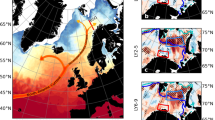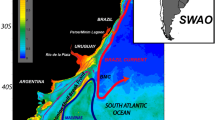Abstract
The Barents Sea is a high latitude ecosystem and is an important nursery and feeding area for commercial fish stocks such as cod, capelin and herring. There is a large inter-annual variability both in physical and biological conditions in the Barents Sea. Understanding and predicting changes in the system requires insight into the coupled nature of the physical and biological interactions. A coupled physical and biological ocean model is used to study the impact of postulated future atmospheric changes on the physical and biological conditions in the Barents Sea. Results from this simulation not only show that there is a large variability in the physical conditions on a wide range of time scales, but also that the temperature in the Barents Sea is increasing. The corresponding ice cover decrease is most noticeable in the summer months. The changes in physical properties will most likely have an impact on the biotope. On average, the primary production increases slightly over a 65 year long period, about 8%, partly due to an increased production in the northern Barents Sea. The model further simulates that the production of Atlantic zooplankton species increases approximately 20% and becomes more abundant in the east. The Arctic zooplankton biomass decreases significantly (50%) causing the total simulated production to decrease.
Similar content being viewed by others
References
Aagaard K, Woodgate RA (2001) Some thoughts on the freezing and melting of sea ice and their effects on the ocean. Ocean Model 3:127–135
Anon (2004) Survey Report from the joint Norwegian/Russian ecosystem Survey in the Barents Sea in August–October 2004 (vol. 1). IMR/PINRO Joint Report Series, No 3/2004. ISSN 1502-8828, p 68
Anon (2005a) Extended survey report from the joint Norwegian/Russian ecosystem Survey in the Barents Sea in August–October 2004 (vol. 2). IMR/PINRO Joint Report Series, No 1/2005. ISSN 1502-8828, p 83
Anon (2005b) Survey Report from the joint Norwegian/Russian ecosystem Survey in the Barents Sea in August–October 2005 (vol. 1). IMR/PINRO Joint Report Series, No 3/2005. ISSN 1502-8828, p 99
Blindheim J (1989) Ecological features of the Norwegian Sea. In: Rey L, Alexander V (eds) Proceedings of the Sixth Conference of the Comite Arctique International, 13–15 May 1985, E,J. Brill, Leiden, The Netherlands, pp 366–401
Dalpadado P (2002) Inter-specific variations in distribution, abundance and possible life cycle patterns of Themisto spp. (Amphipoda) in the Barents Sea. Polar Biol 25:656–666
Dalpadado P, Bogstad B (2004) Diet of juvenile cod (age 0–2) in the Barents Sea in relation to food availability and cod growth. Polar Biol 27:140–154
Dalpadado P, Skjoldal HR (1996) Abundance, maturity and growth of the krill species, Thysanoessa inermis and T. longicaudata in the Barents Sea. Mar Ecol Prog Ser 144:175–183
Dankers R, Middelkoff H (2008) Snow cover, river discharge and freshwater runoff to the Barents Sea under present and future climate conditions. Clim Change DOI 10.1007/s10584-007-9349-x
Gjøsæter H, Dalpadado P, Hassel A (2002) Growth of Barents Sea capelin (Mallotus villosus Müller) in relation to zooplankton abundance. ICES J Mar Sci 59:959–967
Göttel H, Alexander J, Keup-Thiel E, Rechid D, Hagemann S, Blome T, Wolf A, Jacob D (2008) Influence of changed vegetations fields on regional climate simulations in the Barents Sea Region. Clim Change DOI 10.1007/s10584-007-9341-5
Helland-Hansen B, Nansen F (1909) The Norwegian Sea, its physical oceanography based upon the Norwegian Researches 1900–1904. Rep. on Norw. Fishery and Marine Investigations vol. II (1), Det Mallingske Bogtrykkeri, Kristiania p 390
Hibler WD III (1979) A dynamic thermodynamic sea ice model. J Phys Oceanogr 9:815–846
Hirche HJ, Kwasniewski S (1997) Distribution, reproduction and development of Calanus species in the Northeast Water in relation to environmental conditions. J Mar Syst 10(1–4):299–317
Hjort J (1914) Fluctuations in the great fisheries of northern Europe viewed in the light of biological research. Rep Pro Réun Con Int l’Explor Mer 20:1–228
Hunke EC, Dukowicz JK (1997) An elastic-viscous-plastic model for sea ice dynamics. J Phys Oceanogr 27:1849–1867
Ingvaldsen RB, Asplin L, Loeng H (2004) The seasonal cycle in the Atlantic transport to the Barents Sea during the years 1997–2001. Cont Shelf Res 24:1015–1032
Jacob D (2001) A note to the simulation of the annual and interannual variability of the water budget over the Baltic Sea drainage basin. Meteorol Atmos Phys 77(1–4):61–73
Koptev AV, Nesterova VN (1983) Features of longitude distribution of summer feeding plankton in the Eastern areas of the Barents Sea. Research of biology, morphology and physiology of hydrobionts.–Apatity:22–28
Loeng H (1989a) The influence of temperature on some fish population parameters in the Barents Sea. J North west Atlantic Fish Sci 9:103–113
Loeng H (1989b) Ecological features of the Barents Sea. In: Rey L, Alexander V (eds) Proceedings of the Sixth Conference of the Comite Arctique International, 13–15 May 1985. EJ Brill, Leiden, The Netherlands, pp 327–365
Loeng H (1991) Features of the physical oceanographic conditions of the Barents Sea. Polar Res 10:5–18
Loeng H, Bjorke H, Ottersen G (1995) Larval fish growth in the Barents Sea. Can Spec Pub Fish Aquat Sci 121:691–698
Loeng H, Brander K, Carmack E, Denisenko S, Drinkwater K, Hansen B, Kovacs K, Livingston P, McLaughlin F, Sakshaug E (2005) Marine Systems in ACIA, Arctic Climate Impact Assessment. Cambridge University Press, pp 453–538
Melle W, Skjoldal HR (1989) Zooplankton reproduction in the Barents Sea: vertical distribution of eggs and nauplii of Calanus finmarchicus in relation to spring phytoplankton development. In: Ryland JS, Tyler PA (eds) Reproduction, genetics and distribution of marine organisms. Fredensborg, Denmark, pp 137–145
Mesinger F, Arakawa A (1976) Numerical methods used in atmospheric models, vol. I. WMO/ICSU Joint Organizing Committee. Garp Publication Series. No. 17
Midttun L (1985) Formation of dense bottom water in the Barents Sea. Deep-Sea Res 32:1233–1241
Nilssen KT, Pedersen OP, Folkow LP, Haug T (2000) Food consumption estimates of Barents Sea harp seals. NAMMCO Sci Publ 2:9–27
Rey F (2004) Phytoplankton: the grass of the sea. In: Skjoldal HR (ed) The Norwegian Sea Ecosystem. Tapir Academic Press, Trondheim, Norway, pp 97–136
Rudels B, Jones EP, Anderson LG, Kattner G (1994) On the intermediate depth waters of the Arctic Ocean. In: Johannessen OM, Muench RD, Overland JE (eds) The role of the polar oceans in shaping the global climate. American Geophysical Union, Washington DC, pp 33–46
Sakshaug E, Bjørge A, Gulliksen B, Loeng H, Mehlum F (1994) Økosystem Barentshavet. Universitetsforlaget (2. utgivelse), Oslo. p 340
Sameoto D, Wiebe P, Runge J, Postel L, Dunn J, Miller C, Coombs S (2000) Collecting zooplankton. In: Harris R, Wiebe P, Lenz J, Skjoldal HR, Huntley M (eds) ICES zooplankton methodology manual. Academic, London, pp 55–81
Schauer U, Muench RD, Rudels B, Timokhov L (1997) Impact of eastern Arctic shelf water on the Nansen Basin intermediate layers 102:3371–3382
Schauer U, Loeng H, Rudels B, Ozhigin V, Dieck W (2002) Atlantic water flow through the Barents and Kara Sea. Deep-Sea Res I 49:2281–2298
Skjoldal HR, Gjøsæter H, Loeng H (1992) The Barents Sea ecosystem in the 1980s: ocean climate, plankton and capelin growth. ICES Mar Sci Symp 195:278–290
Slagstad D, McClimans TA (2005) Modeling the ecosystem dynamics of the Barents sea including the marginal ice zone: I. Physical and chemical oceanography. J Mar Syst 58:1–18
Slagstad D, Wassmann P (1996) Climatic change and carbon flux in the Barents Sea: 3-D simulations of ice-distribution, primary production and vertical export of particulate organic carbon. Memoirs of National Institute of Polar Research, 51 (Special Issue): 119–141
Slagstad D, Downing K, Carlotti F, Hirche HJ (1999) Modelling the carbon export and air-sea flux of CO2 in the Greenland Sea. Deep-Sea Res Part II–Trop Stud Oceanography 46:1511–1530
Wassmann P, Slagstad D, Riser CW, Reigstad M (2006) Modelling the ecosystem dynamics of the Barents Sea including the marginal ice zone II. Carbon flux and interannual variability. J Mar Syst 59:1–24
Author information
Authors and Affiliations
Corresponding author
Rights and permissions
About this article
Cite this article
Ellingsen, I.H., Dalpadado, P., Slagstad, D. et al. Impact of climatic change on the biological production in the Barents Sea. Climatic Change 87, 155–175 (2008). https://doi.org/10.1007/s10584-007-9369-6
Received:
Accepted:
Published:
Issue Date:
DOI: https://doi.org/10.1007/s10584-007-9369-6




